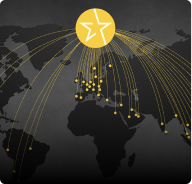Recognizing and rewarding the positive contributions of employees at any company is critical to driving employee engagement, culture, morale and most importantly, retention. In fact, there are companies that help other companies drive employee recognition. And we’ve been partnering with one of the fastest growing ones for the past 6 years to help them innovate, differentiate and stay ahead of their own competition.
Category: Employee Recognition
7 Steps to Create a Successful Employee Recognition Program

Employee recognition programs are the backbone of a positive company culture where workers feel valued and appreciated. Launching one has no downsides, but it does take some effort and creativity on the employer’s part.
The most important thing to remember is employees are a company’s most valuable asset. Their satisfaction and motivation directly affect business outcomes. Formalizing a recognition and rewards system boosts performance, employee retention, and employer brand.
Jump in to learn how to build, launch, and refine a recognition initiative that delivers powerful results.
1. Assess current practices
The first step to revamping an employee recognition program is to audit current practices. Even without a formal system in place, it’s essential to see how recognition culture currently operates.
Speak to a group of employees with varying levels of tenure and hierarchy. Diversify across departments and locations to understand how consistent accolades and rewards are delivered.
2. Define program goals
After establishing what is and isn’t working, it’s time to formalize the program objectives. A strong recognition program uses the organization’s values as a base. Company culture, employer brand strategies, and overarching business drivers heavily influence these goals.
Consider what this initiative needs to accomplish and deploy the SMART criteria to ensure goals are specific, measurable, achievable, relevant, and time-oriented. A few examples could include:
- Increase employee retention by 10 percent within six months
- Reach 80 percent uptake within one year of program launch
- Boost employee referrals by 20 percent within three months
To make goals measurable, you’ll need a baseline for employee satisfaction, turnover, retention, and engagement metrics. Work with HR, internal communications, and IT teams to understand the current data points.
3. Identify employee preferences
Understanding what motivates employees is critical to keeping them feeling appreciated and content.
Use surveys to glean employee feedback on preferences for praise, the types of rewards they’re interested in, and how they feel about the current company culture. Some companies resort to culture meetings or focus groups to better understand the sentiment surrounding rewards programs.
Refer to reputable studies like Deloitte’s Total Rewards and Workforce Experience report. It highlights how public praise from senior leadership, direct supervisors, and colleagues is a form of recognition employees prefer the most.
4. Draft a recognition program
Annual, performance-based recognitions and rewards are routine and occur behind closed doors or in private meetings. Since employees thrive on public and frequent praise, public recognition is crucial to success.
Reaching major milestones and overcoming obstacles are excellent activities to recognize. Workers also appreciate all kinds of positive feedback, including celebrating life events, small wins, and daily notes of gratitude.
Peer-to-peer recognition is an important way to encourage public acknowledgment of a job well done and contributes to a supportive team mentality. The ideal program makes praise and rewards easy to share, ties efforts to company values, and connects different teams.
5. Identify the rewards or incentives for the program
Employees feel more satisfied when they believe their employer cares about their interests and well-being. Yet, generic rewards or one-size-fits-all approaches for unpopular prizes fail to convey this concern.
Personalizing rewards makes the experience more valuable to workers. For instance, offering workers a choice of gift cards for over 2000 stores or choosing from a selection of brands that speak to the interests of team members.
Offering choice demonstrates the company’s commitment to worker satisfaction. As workplace diversity increases, rewards must be more personalizable to appeal to most employees.
6. Choose the right tools and platforms
Employee recognition platforms foster participation through gamification and social recognition, all while ensuring accessibility across organizations.
Ensure the platform supports scalability, user-friendliness, and customization. Prioritize options that integrate with HR and communication software and allow API connections with bulk gift card providers. This approach reduces the cost of rewards and makes distribution more efficient.
Investing in recognition platforms lets employees know the program is a priority.
7. Announce and launch the program
Effective communication and employee buy-in lead to strong program adoption.
Create a communication strategy explaining the system’s details, benefits, and participation methods. Utilize multiple channels to reach employees where they are most receptive.
Choose an executive or team of leaders to support the program publicly and encourage participation. Once launched, these higher-ups must be visibly active and motivational on the platform.
Follow up with additional reminders after the initial launch. Encourage participation by sharing success stories, holding training sessions, and incentivizing early adopters.
Tips for successful recognition programs
Employee recognition programs are ongoing initiatives. They need refinement as time goes on. Use these additional tips to keep things impactful:
Solicit feedback after the first few weeks. Identify areas that need more clarification, training, or customization.
Use gamification to keep employees involved. Point systems, engagement badges, and leaderboards encourage healthy competition.
Train managers on how to effectively acknowledge employees. Consistent recognition impacts worker satisfaction and motivates others to heap praise on the praise.
Track participation and recognition frequency rates. Check-in on the progress of the original objectives and adjust accordingly.
Include the program in the employee recruitment and onboarding processes. If it’s a priority, it should be one of the first things new employees learn about the company.
Conclusion: Personalize employee achievement with a brand they love
A well-designed recognition program includes public and frequent praise tied to the company’s core principles. Clear and measurable objectives aligned with company values influence engagement and impact. The opportunity for peers to recognize each other is a key component.
Effective communication and leadership support ensure strong program adoption. Choosing the right platform and prizes is fundamental to success. Corresponding tools must be scalable, user-friendly, and efficient.
It’s wise to connect with workers frequently to understand their reward preferences. This approach keeps employees motivated and demonstrates the importance of workers’ interests and well-being to the company.
Explore how bulk gift cards offer the personal touch to reward-based recognition programs employees appreciate the most.
Request a demo to learn how much you’ll save by integrating bulk gift cards from NeoCurrency into your employee recognition program.
Recommended articles (helpful links)
- Employee Recognition: How Employees Want To Be Rewarded
- The Power of Choosing the Right Gift Card API Provider
- Unlocking Success: Elevating Mobile Phone Upgrades
Employee Recognition: How Employees Want To Be Rewarded

Turnover and quiet quitting create serious consequences for businesses. Reviewing your company’s recognition culture and reward system has never been more important.
Employee recognition has the potential to improve retention and productivity. However, traditional programs often fail to meet employee expectations.
Acknowledging project milestones, personal achievements, and contributions of all sizes is vital for supporting and improving company morale.
This article explores the benefits of positive feedback, the recognition workers prefer, and the latest trends shaping successful recognition programs.
How do employee rewards and recognition motivate an employee?
Employee rewards and recognition motivate employees to do excellent work and help them feel more appreciation from employers.
Gallup reports employees are 73 percent less likely to experience burnout when positive feedback is a core component of company culture.
Employees who regularly receive recognition are also 56 percent less likely to look elsewhere for other job opportunities.
In a competitive job market—and especially in fields where talent shortages are common—keeping workers content through acts of appreciation is a low-effort, high-reward practice.
Successful recognition programs improve employee retention, engagement, and performance.
What are the different ways of recognizing employees?
Recognizing employees in the workplace happens in a variety of ways, including shoutouts in meetings, team lunches, gift cards, company awards, and private compliments. Other popular methods include memorable experiences like wine tasting, company swag, or donations to a charity in the employee’s name.
Differentiating between compensation and recognition is crucial. BambooHR says one-third of employees would rather be recognized for their work accomplishments in a company-wide email from an executive than receive a private $500 cash bonus. Cash bonuses feel transactional, and employees learn to expect them as part of their normal compensation.
On the other hand, gift cards serve as a symbol of recognition, not compensation. This form of recognition speaks more closely to a person’s interests, and the act creates a memorable experience attached to a prestigious brand name.
What are the current trends in employee recognition?
The main trends affecting employee recognition programs are peer-to-peer recognition, personalized rewards, reviewing frequency, and gamification.
1. Technology and gamification
Employee recognition platforms help formalize company programs and ensure they are accessible to all workers. These tools offer an element of gamification that keeps employees engaged and empowered to recognize their peers consistently.
Point systems, leaderboards, digital badges, and real-time prize claims are standard features that create a playful environment while reinforcing the trends above.
2. Increasing recognition frequency
Regular rewards have a more positive impact on work performance than annual rewards. The Incentive Research Foundation (IRF) reports that offering more frequent rewards is more beneficial to work performance than a sizable annual reward. Ongoing recognition supports high motivation and productivity levels among employees throughout the year, keeping engagement levels high and preventing burnout.
The shift towards frequent rewards creates an opportunity for coworkers to recognize and participate in the reward system for their peers.
3. Peer-to-peer accolades
Peer recognition programs are more prevalent than ever and help employees feel more valued and engaged. Micro-recognitions build a culture of appreciation among team members and keep workers consistently productive year-round. Regular peer acknowledgment builds a culture of appreciation among team members and keeps workers productive year-round.
4. Personalization
Catering to a more diverse workforce means offering rewards and recognition that speak to individual employee preferences.
Deloitte ties personalization to business success by underscoring how high-performing companies are six times more likely to understand employee preferences than their low-performing counterparts.
Gift card rewards are a wise choice for recognition programs because they offer personalization cash bonuses don’t provide.
Understanding different employee preferences for recognition
Employees have varying preferences for recognition that vary based on generation and job environment.
Millennials and Gen Z thrive on frequent feedback. The Society for Human Resource Management (SHRM) reports that 79 percent of Gen Z and Millennials said increasing recognition rewards would make them more loyal to their employer.
Since younger generations grew up in a digital world, online-based platforms with peer-to-peer-driven rewards are second nature. They’re also commonplace applications in remote work environments.
On the other hand, older generations don’t expect immediate or ongoing feedback and hold more appreciation for antiquated forms of recognition like handwritten notes, employee spotlights in newsletters, and formal awards like Employee of the Month.
Employers bridge these generational preferences by embracing versatile rewards (like bulk gift cards) that appeal to younger and older employees in various workplace settings.
Conclusion: Bulk gift cards for employee recognition
Employee recognition and rewards programs drive employee retention and foster a strong company culture.
Recognition takes many forms, including public praise, peer-to-peer recognition, and rewards programs with gift cards. Current trends in employee rewards include digital peer-to-peer systems, gamification, increasing reward frequency, and personalized prizes.
Gift cards are one of the most popular and universally appreciated rewards for personalizing rewards in recognition programs. NeoCurrency offers 2000 choices in 50 countries for bulk gift cards that fit seamlessly into your company’s employee recognition program.
Request your demo to learn how much you can save on bulk gift cards from NeoCurrency for your employee reward program.
Recommended articles (helpful links)
The Power of Choosing the Right Gift Card API Provider
By Eric Thiegs, Head of Strategy & Growth, NeoCurrency
Over my 25 years in the gift card industry, I’ve had a front row seat to the evolution of the industry. One of the most impactful developments was the introduction of gift card APIs.
In fact, I had the opportunity to be involved in launching one of the first gift card APIs to service real-time eGift distribution to both end users and corporate clients for B2B use cases in the loyalty, reward, and incentive industries. The revolution was on.
That was over 10 years ago.
Gift Card APIs in the present
Since then, APIs and gift cards have continued to change in myriad ways. So have the providers and the solutions they offer. It’s a dynamic and competitive industry, and choosing the wrong partner can cost a lot more than money. After all, the whole reason to utilize gift cards is to reward, engage or incentivize in some way, an employee, customer, member, participant or prize winner. Poor execution or under-delivery can have the exact opposite effect on your business or reputation that you were looking and paying for—and possibly even lead to legal issues.
“It’s a dynamic and competitive industry,
and choosing the wrong partner can cost a lot more than money”
In order to help you choose the right digital reward provider for your needs, I’ve put a checklist together for buyers and decision-makers who are looking to find a gift card API provider and solution both domestically in the US, internationally—or both, that will work best for their needs. The list is based on my experience over the course of my career, as well as what we hear from our own clients here at NeoCurrency every day. Asking providers to share details on each of the below API attributes, features, benefits, use cases and pricing will help you select the best gift card API.
1. What reward content does their Gift Card API offer?
A gift card API is only as good as its content, and so the most important feature of the best reward APIs is the ability to offer a wide variety of brands that provide flexibility and choice. Ask your gift card provider if the following products can be supplied through their API integration.
• Closed Loop Cards: Brands ranging from Amazon, Google Play, Apple, Starbucks, etc.
• Open Loop Prepaid Cards: VISA, MasterCard, American Express, etc.
• Cash-Like Rewards: PayPal, Venmo
• Digital Currency Rewards: Bitcoin, Ether, Dogecoin, etc.
• Choose-your-own reward option: A universal reward link that allows the end recipient to select their reward/gift card
• What, if any, other prizes, coupon codes, or digital content can be delivered in their API?
2. What currencies and countries are supported by their API?
Some clients need content relevant in one country. Others need eGift Cards with popular brands across a multi-country regions, an entire continent, or all of the above. Beyond the brands, it’s important to be able to deliver rewards in the appropriate currencies for many reasons. Understanding a partner’s capabilities domestically and across the globe is key, especially if there’s a chance you’ll need coverage in a new region as your platform grows.
3. How easy is the integration of their Gift Card API?
Most Gift Card APIs boast a suite of powerful features from seamless ordering and robust security options to easy, free sandbox access for testing. Getting access to all of the great features; however, can be a challenge. You’ll want to ask your provider about how quickly the API can be deployed and inquire if the API documentation is developer-friendly. You’ll also want to know if it’s easy to work with the provider’s team to launch sandbox testing and move quickly into production. A tech call with your potential provider will quickly tell you how collaborative, supportive, and trustworthy the team is behind the API solution. If they don’t want you to talk to their tech representatives, it’s probably a red flag.
4. What kind of account support do they offer?
On-going account support is a key attribute that sets many Gift Card APIs apart. Whether you’re a small business or an enterprise-level corporate client, the reward API you use should grow with you. And you should have the support you need to answer questions and troubleshoot issues. Whether it’s new content, 24/7 self-serve account access, or strong customer service, you’ll want to ask your potential partner to outline, specifically, how they will support your account.
5. What are the KPIs of their Gift Card API?
Key Performance Indicators (KPIs) are the lifeblood of every good API. Ask your potential gift card provider for metrics around the up-time, load tolerance, scalability, and error rate of their API. Because let’s face it, if the API doesn’t work, it will hurt you. You’ll want to understand the platform’s reliability, downtime risk, and other performance attributes that may impact the API service.
6. What are the costs and fees associated with their API?
Not all Gift Card APIs use the same pricing structure. To get a transparent understanding of the commercial components, you’ll want to ask your provider about all fees associated with their API including the cost of the eGift or prepaid products sourced through the API, setup fees, transaction fees, delivery fees, email template fees, email delivery fees, SaaS fees, or hosting/service fees.
NeoCurrency Stacks up.
Since I’m suggesting you ask all of these questions to any gift care API provider you are interested in talking with, here is a quick cheat sheet of how we would answer these questions at NeoCurrency.
1. What reward content does NeoCurrency’s Gift Card API offer?
NeoCurrency offers over 2,000 digital reward options from the biggest brands you expect, to more localized relevant brands that provide more unique offerings around the world—all through a single API integration.
2. What currencies and countries are supported by NeoCurrency’s Gift Card API?
NeoCurrency’s API content covers 140+ countries across six continents in 50 currencies. We offer a multi-currency, global API for clients who need just one country/currency or those that need access to digital rewards across the world. Among many other benefits, being able to redeem in so many currencies helps our clients save money on conversion fees they’d otherwise have to pay.
3. How easy is the integration of NeoCurrency’s Gift Card API?
The team here at NeoCurrency takes pride in our ability to quickly and easily support clients who are integrating into our gift card API. This includes:
• A four-tier account service support structure
• Fast access to sandbox account access with test funds
• Same day/24-hour turn time on technical questions during integration
• Fast production turn time
We’ve been grateful to have clients praise us on our integration support and turn-time. If APIs provide real-time access to rewards, the team supporting the integration should be as real-time as possible during the set-up, too.
4. What kind of account support does NeoCurrency offer?
Taking care of our clients is something we’ve prided ourselves on since we started the company. We focus relentlessly on providing:
• Global multi-time zone account service support
• 24/7 self-service access and control to your API via an account dashboard
• Real-time, self-service reporting available 24/7
• Full program assets available for download 24/7 (brand logos, T&Cs, card images, etc) within your dashboard
• 4-tiered account service support structure that includes customer service, client success, executive and C-level contacts
5. What are the KPIs of their Gift Card API?
At NeoCurrency, we work hard to make sure your rewards are getting where they need to go, when you want them to get there. We are proud to consistently track in the very top of some critical industry KPIS including:
• 99.999% uptime
• 0.002% error rate
• 1-2 second avg API response time
6. What are the costs and fees associated with NeoCurrency’s API?
We’re allergic to fees here at NeoCurrency which is why you’ll pay:
• NO set-up fees
• NO transaction fees
• NO delivery fees
• NO email template fees
• NO email delivery fees
• NO SaaS fees
• NO hosting/service fees
• NO minimums
Our pricing is simple. Our clients pay as they go for the reward content they order through the API. We have a global rate that can be sent for review, and pricing is accessed in the client’s API dashboard for viewing and reporting 24/7.
Summary
Today’s Gift Card APIs are very different than the ones I began implementing with clients 10 years ago. Your program deserves the best reward API provider; one that offers a comprehensive solution that not only meets but exceeds industry standards and offers you the scalability, security, content, and global reach to make your programs successful.
I hope you find this list to be helpful, and I’d be happy to answer any other questions you may have about the general gift card API marketplace or, specifically, our NeoCurrency reward API solution. All of us at NeoCurrency think we have something uniquely special here, and we’d love to share it with you in detail.




